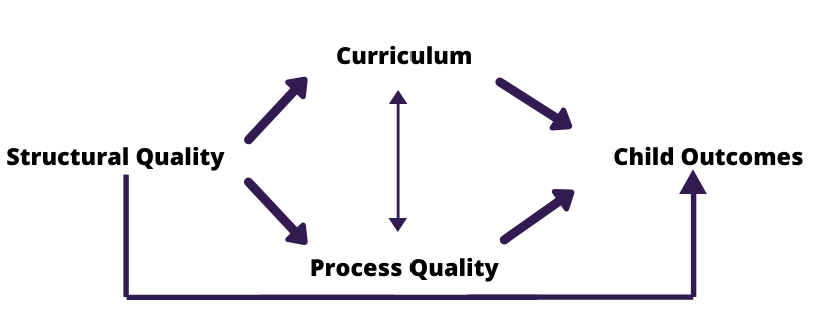14 Process Quality and Structural Quality
Unlike standard industry practices, high-quality practices place an emphasis on promoting positive child outcomes. The key to a high-quality program is contingent upon what happens inside the classroom environment. Let’s examine how both process quality and structural quality work together to influence positive outcomes for children.
Process quality refers to the types of interactions that occur throughout the day between the teachers, children, families, and administrators. Process quality also considers the types of materials that are available for the children to use, as well as the activities that children engage in throughout their day. Lastly, process quality takes into account the health, well-being and safety of the children. Structural quality on the other hand, refers to the features and characteristics of a program. More specifically, the class size, teacher-to-child ratios, teacher qualifications and experiences, teacher pay scale, along with the allotted square footage for play space define quality. Although process quality is thought to have a more direct impact on child outcomes as compared to structural quality , researchers and leaders in the field of early care and education agree that process and structural indicators are interrelated, and when combined together they promote the highest quality experiences.
For example, when groups are smaller, teachers tend to have more positive, supportive, and stimulating interactions with children. Warm and nurturing interactions are directly linked to children’s social competence and future academic success, and such interactions are essential to high quality. Early childhood teachers who are more highly qualified and have smaller groups can more effectively provide individualized, responsive learning opportunities. Finally, higher teacher wages have consistently been linked to higher process quality. [1]
Diagram that illustrates how structural quality leads to curriculum and process quality which are connected. Curriculum and process quality both lead to child outcomes. Ultimately the diagram illustrates that structural quality directly leads to child outcomes.

- NIEER. (2002). High Quality Preschool: Why We Need It and What It Looks Like. Retrieved from: https://www.readingrockets.org/article/high-quality-preschool-why-we-need-it-and-what-it-looks ↵

